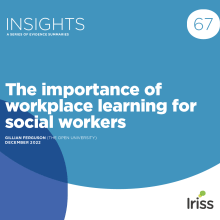Background
One of Iriss's private sector Champions, Aspris Children's Services (formerly Aspire Scotland Ltd), has been shortlisted for an award at the SSSC Care Accolades.
Aspris Children's Services believes that high quality social care and education requires a skilled workforce and so developed a pilot project in conjunction with Kilmarnock College which set out to improve the learning of staff. This pilot took a fresh approach to teaching and learning by using a managed virtual learning and teaching environment (VLE) which was accessible over a 24/7 period.
What was the project?
Aspris Children's Services wanted to start small with a pilot so that they could determinate the usefulness of the approach. It allowed them to make iterative adjustments to the programme, which enabled a level of flexibility to see what worked, what didn't and to use the feedback from participants for improvement.
An online training programme was created to deliver aspects of continuous personal development (CPD) and post registration teaching and learning (PRTL) to an identified number of care and education workers. This programme emphasised interactive learning, shared viewpoints, assessment and tutor mentoring and challenge. In addition, scenario based learning was used to assist workers to reflect on their practice with a clear view to individual and collective improvement.
Why try out this new approach?
The pilot initiative set out to find a new approach, which would address an old problem. Traditionally CPD activity for care staff would normally be by means of CPD workshops, primarily tutor led with limited options for participation, assessment, reflection and application of theory. Employee attendance can also be costly. Through joint partnership meetings both parties agreed that innovative use of VLE should be a priority area of interest for development.
Aspris Children's Services and Kilmarnock College were keen to create a learning system that would be similar to what people would use in their everyday lives. With the rise in the use of social media (Facebook, twitter etc.) they were keen to develop something similar that staff wouldn't need to learn to use for an education focus.
Outcomes
'My new knowledge has informed my practice in a variety of situations already and I will continue to reflect and consider this knowledge on a daily basis when supporting our young people'
'The Scenario Based Learning (SBL) enabled me to reflect on situations that I have a good working knowledge of and to discuss the theories and my thoughts with others in a similar situation to myself. The training was particularly helpful in making the theories as succinct as possible, but allowed the opportunity to access further reading if you wished to do so'
'Through sharing of information, other views can be taken into consideration that may previously not have been considered'
'An enjoyable, informal approach to CPD that is inspiring and motivating'.
(Comments from participants)
It became apparent throughout the project that the online aspect of the course allowed for increased student participation, which would have been otherwise not been possible. Staff were able to learn without needing to leave the workplace; they could fit training around their workload and personal time. They were able to repeat areas that they found difficult and learning and teaching became measurable and embedded in practice. The training was much more efficient and cost effective as potential hours of work lost while training was reduced, staff replacement costs were removed.
Similarly, staff from education and social care worked together on the pilot around the same outcomes. This has traditionally been difficult as staff from these different backgrounds can have different principles that underpin their work. However, the fact that all staff were exposed to the same literature and scenarios led to greater understanding of different values and points of view and allowed people to share experiences.
The provision of assessments and blog forums allowed tutor and management staff an opportunity to gauge the progress, engagement, motivation and aptitude of the students. It was also possible to track user access and participation in the course, particularly through their interactions within blogs etc. The use of additional scenarios helped capture the relevance for practice. Individuals also clearly expressed that the similarities between the approach to learning in the course and the type of technology used in social network sites resulted in them feeling very comfortable with the model, as a result they reported feeling more receptive to the process.
Testing the approach out in the pilot allowed training materials to be targeted at individual employee's previous attainment levels. Training was set at levels 7 and 10 on the Scottish Credit and Qualifications Framework (SCQF) scale and staff were encouraged to work across levels and to partake in analytical discussion. Similarly, staff were also able to learn at their own pace - the evaluation showed that staff accessed the course from early morning to late evening. Mapping individual course access provided evidence that learning and teaching materials should be available over a 24/7 period.
he design of the VLE proved to be robust, versatile and user friendly and the expertise between the partners e.g. Heads of department, tutors and ICT management provided the necessary direction and supports to fulfill the pilot aim.
Enablers
- Effective working relationships between partners - the relationships that developed between Aspris Children's Services and Kilmarnock College were a useful vehicle for the development of the programme. This relationship was focused on their shared goals - meeting the demands of the sector and testing out new ways of delivering training.
- Commitment and motivation from staff - an open call for notes of interest in the training was sent out to all staff. 12 out of 15 put themselves forward. The enthusiasm, honesty and openness of staff was a key enabler at the pilot stage as their feedback was invaluable to the development of the programme.
- Link to the Continuous Learning Framework - we measured staff development by discussing progress on the programme in staff support and supervision. This allowed us to have a focused discussion and was really useful as it encouraged staff to take ownership for their own learning. Similarly, staff were able to see their own progress moving through the different stages, which proved to be very motivating.
What next?
Following discussions within the partnership, there are now plans to create a fully developed teaching and learning framework targeted specifically at the HNC social care programme, and SVQ level 3 in particular. This approach will widen access for potential students who for various reasons have great difficulty in accessing traditional college training.
Additionally, Scenario Based Learning (SBL) can be developed into a full CPD/PRTL programme for wider care and education sectors in direct response to declared needs which can often follow care inspectorate recommendations and requirements.
The success of the pilot has convinced Aspris Children's Services that the model could be transferable to children and young people. As such, there are further plans for Aspris Children's Services to develop its existing VLE (Educare 24), which provides 24/7 access to teaching and learning for children and young people in the 3-18 year age range.
As well as Aspris Children's Services being shortlisted for the SSSC Care Accolades, Kilmarnock College has also received a celebration of excellence from HM Inspectorate of Education (HMIe).
What advice would you give to others?
- Form good relationships within the partnership and work towards a shared vision
- Record your outcomes - how will your programme impact on the skills base and how will it make a difference?
- Link the work into existing organizational processes e.g. linking into the CLF.
- Reward staff achievement.


